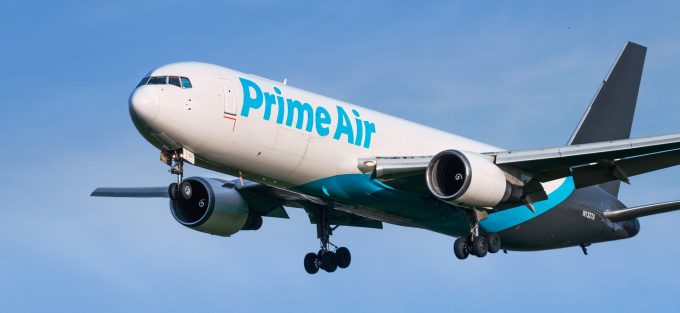UPS drama – a Premium back and forth on key bits and pieces
Network power
TFII: SOLID AS USUALMAERSK: WEAKENINGF: FALLING OFF A CLIFFAAPL: 'BOTTLENECK IN MAINLAND CHINA'AAPL: CHINA TRENDSDHL: GROWTH CAPEXR: ANOTHER SOLID DELIVERYMFT: HERE COMES THE FALLDSV: LOOK AT SCHENKER PERFORMANCEUPS: A WAVE OF DOWNGRADES DSV: BARGAIN BINKNX: EARNINGS OUTODFL: RISING AND FALLING AND THEN RISING
TFII: SOLID AS USUALMAERSK: WEAKENINGF: FALLING OFF A CLIFFAAPL: 'BOTTLENECK IN MAINLAND CHINA'AAPL: CHINA TRENDSDHL: GROWTH CAPEXR: ANOTHER SOLID DELIVERYMFT: HERE COMES THE FALLDSV: LOOK AT SCHENKER PERFORMANCEUPS: A WAVE OF DOWNGRADES DSV: BARGAIN BINKNX: EARNINGS OUTODFL: RISING AND FALLING AND THEN RISING

Amazon is offering fulfilment to merchants selling on the BigCommerce platform – a move that signals a growing appetite for third-party delivery businesses and increasing competition for UPS and FedEx.
BigCommerce, a competitor of Shopify, is integrating Amazon’s Multi-Channel Fulfilment (MCF) service into its platform for its US clients, giving them the same service options as users of the Fulfilment By Amazon (FBA) service.
They send the goods to Amazon fulfilment centres for delivery on one- to five-day services.
“Amazon MCF will help our merchants to better plan, purchase and fulfil in a much more efficient way,” said Sharon Gee, general manager of omnichannel at BigCommerce.
Using MCF allows vendors to show at check-out when delivery will be made and to track the shipments. In addition, they benefit from Amazon strategically placing goods close to customers for faster delivery, according to to the online retailer.
Vendors have control over the cost of shipping for consumers and are able to replace the Amazon rate with a flat fee or free shipping, paying for storage and fulfilment – including pick, pack and ship – with no peak surcharges.
The latter point is likely to strike a chord with merchants that have seen the integrators raise surcharges repeatedly over the past year. Moreover, it gives them an alternative fulfilment channel at a time when parcel delivery firms are struggling to cope with volumes, and are trying to control traffic through higher charges and/or volume limits.
Amazon does have limits on how much merchants can ship to its fulfilment centres, however, these are the same as for its FBA clients, according to the company.
So far MCF has not made a significant splash in the market, commented Rick Watson, founder and CEO of e-commerce consulting firm RMW Commerce.
“We don’t have many customers that are using it,” agreed John Haber, CEO of parcel logistics consulting firm Spend Management Experts.
However, in a market where capacity is strained and FedEx and UPS are capping enterprise customers unless they pay premiums, the new option should be attractive to merchants selling on BigCommerce, he added.
BigCommerce claims to be used by tens of thousands of B2B and B2C customers across 150 countries and Mr Watson estimates that it is about one-sixth to one-seventh of the size of Shopify, which has been growing faster.
Mr Haber regards the move as an indication that Amazon no longer feels hamstrung by constraints imposed by the pandemic and the resultant surge in volumes that slowed down its drive for next-day delivery as standard service for Prime customers.
“It’s very clear they feel confident their service levels are strong enough to take on that new volume,” he said. “That’s good news for consumers, but not good news for FedEx and UPS.”
He regards the integration of MCF into the BigCommerce platform as a signal that Amazon is getting ready to turn up its nascent drive to compete with the integrators for third-party traffic in its delivery network.
“They’ve moved outside the realm of shipping only Amazon and FBA traffic.”
FedEx has already cut ties with Amazon, but UPS derives about 10% of its revenues from there, Mr Haber said, adding that he thinks both sides are looking to reduce their mutual dependence.
Spend Management projects the parcel market to grow at a rate of 15-20% for the next five years, with many small and mid-sized vendors popping up with significant volumes of traffic.
“I suspect UPS has a plan to backfill the Amazon volume loss with that,” he said.
Mr Watson is less sanguine on the BigCommerce integration. While he regards a push by Amazon to compete for parcel business with the integrators as inevitable, he reckons that, for now, the company is still focused on the service aspect for its customers. But sooner or later UPS will be facing rising competition from this corner.
Comment on this article